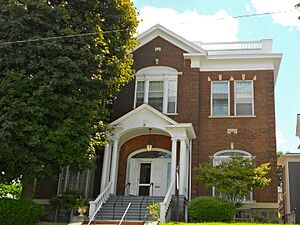Century Club of Scranton facts for kids
Quick facts for kids |
|
|
Century Club of Scranton
|
|
 |
|
| Location | 612 Jefferson Ave., Scranton, Pennsylvania |
|---|---|
| Area | less than one acre |
| Built | 1913-1914 |
| Architect | Blackwood, Harvey J.; Nelson, John |
| Architectural style | Colonial Revival |
| NRHP reference No. | 96000323 |
| Added to NRHP | March 28, 1996 |
The Century Club of Scranton is a historic building located in Scranton, Pennsylvania. It was built between 1913 and 1914. This building was home to a special group called a women's club. Women's clubs were important places where women met to learn, share ideas, and work together to improve their communities. The Century Club building is recognized for its beautiful and classic design.
Contents
What is the Century Club of Scranton?
The Century Club of Scranton was a women's club. These clubs became very popular in the United States. They offered women a chance to gather outside their homes. Members could learn new things, discuss important topics, and organize projects. These projects often helped their local towns and cities. The club provided a place for women to connect and make a difference.
A Look at Its Design
The Century Club building has a style called Colonial Revival. This style was popular in the early 1900s. It looks back to the design of homes from America's colonial past. The building is made of brick, limestone, and wood. It has three stories and a flat roof.
Key Architectural Features
The front of the building is very balanced and neat. It has a special entrance area called a portico. This portico is supported by groups of three columns. These columns are in the Doric order, which means they are simple and strong. The building is quite large, measuring about 56 feet wide and 92 feet long.
A Place of History
Because of its importance and unique design, the Century Club of Scranton was added to a special list. It became part of the National Register of Historic Places in 1996. This list includes buildings, sites, and objects that are important to American history. Being on this list helps protect the building for future generations.




